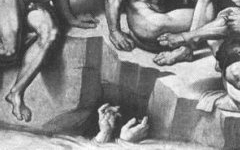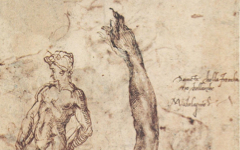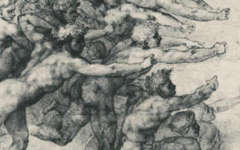Michelangelo’s Sistine Ceiling: Jonah (1512)
The ceiling of the Sistine Chapel is far too complex to address in one of these short articles. Nevertheless, we can shed light on small sections even if you should still read the three-part paper, Michelangelo's Art through Michelangelo's Eyes. It demonstrates simply and comprehensively the hidden, esoteric content of the ceiling which, once viewed, could change your perception of art forever. Michelangelo communicated most of his meaning through dazzling visual illusions, far too remarkable to be accidental or unintended. Here is one of them.

Michelangelo, Jonah (1512) Sistine ceiling, on altar wall above Michelangelo's Last Judgment (1536-41).
Click image to enlarge.
Jonah, swallowed by a whale for three days, was considered an Old Testament prefigurement of Christ which is why Michelangelo chose him as his primary alter ego.1 Jonah is both the largest of the Old Testament prophets on the ceiling and the least dressed; the others are all heavily cloaked. Michelangelo also painted him last. Given his size Jonah leans back to squeeze into the space while admiring the ceiling. His strange position, the subject of much written commentary, is clearly one an artist might take while painting the ceiling, sitting on a scaffold, and leaning back to get more paint from his non-existent palette on the ledge.
Click next thumbnail to continue

Top: Detail of spiritello behind Michelangelo's Jonah
Bottom: Anatomical diagram of an eyeball
Click image to enlarge.
Behind Jonah is a spiritello whose cloak is formed into an anatomical diagram of an eyeball with the optic nerve flowing behind it.2 By placing the spiritello's hand in front of the eyeball, Michelangelo conveys that hand and eye are both critical to art: one representing craft, the other intellect. Many doctors since the 1920's have identified anatomical forms like this one in the Sistine chapel, most of which make sense and add meaning. Here the "diagram" I discovered is further evidence that Michelangelo identified with Jonah as a visual artist.
Click next thumbnail to continue

Top l: Detail of Jonah's fingers
Top r: Diagram of Jonah's fingers
Bottom: Detail of spiritello's head behind Jonah
Click image to enlarge.
In place of brush and palette Jonah's fingers form the profile of a head like that of his spiritello-assistant (see diagram). The negative space between his fingers is a "mental image‟ of what he might or has "painted‟. It is a conception in his mind.
Click next thumbnail to continue

Michelangelo, Jonah (1512) Sistine ceiling, on altar wall above Michelangelo's Last Judgment (1536-41).
Click image to enlarge.
Across from Jonah's hands, on his other side, directly below the eye-like form of the spiritello's cloak, is the whale's large eye as well. Jonah is Michelangelo the artist at work. Nor am I alone in sensing this. Enrico Bruschini writes in a Vatican guidebook: "For me, the figure of Jonah is Michelangelo's artistic testament, his 'signature' on completion of the vast work of frescoing the ceiling.....Jonah bends backwards, almost in rapt admiration and judgment of the ceiling."3 Bruschini is shy of suggesting that Jonah represents the actual artist leaning back to get more paint; for me, though, he clearly does.
More Works by Michelangelo
How a drowning man in the Battle of Cascina has the hands of the artist

Michelangelo’s Hands in The Battle of Cascina (1504)
Notes:
1. Jonah was swallowed by a whale and remained in his stomach for three days before being saved. The parallel with Christ's three-day resurrection thus made Jonah an Old Testament pre-figurement of God's son. Michelangelo likewise identified with Jonah because he too felt that his own powers were God-like and divine.
2. These small figures behind the prophets are often incorrectly described as putti. In 2001 Charles Dempsey corrected the idea that every small naked "putto" in a Renaissance painting is a symbol of Cupid or amor. In the Middle Ages and early Renaissance these figures were known as spiritelli and were illustrations of natural forces in the body and an established feature of medical knowledge. This is very important for our understanding of the Sistine Chapel as an interior view of Michelangelo’s mind. The spiritelli are inside his head because they were literally thought to be inside. They first appeared post-antiquity in foliated borders or holding garlands and have been associated with the Green Man thus making them symbols of fertility and creativity as well. Dempsey writes: “As pneumatic substances, such spirits are not merely allegorical. They have real material and physiological existence. Although having physical existence, they are highly rareified, and in the medical and philosophical thought of the Middle Ages and Renaissance they are conceived as active powers that are the source of all the body’s functions, transmitting nutriment, sensory data and even emotions in airy movement through the tubes of the arteries, veins and nerves.” James Hall later argued that Michelangelo's spiritelli on the Sistine ceiling represent ‘thoughts’ in the prophet's heads, something like thought-bubbles in strip cartoons. See Dempsey, Inventing the Renaissance Putto (Chapel Hill: University of North Carolina Press) 2001, pp. 6-8, 13, 43, 63; Hall, Michelangelo and the Reinvention of the Human Body (New York: Farrar, Straus & Giroux) 2005, pp.117-9
3. Bruschini, The Vatican Masterpieces (Florence: Scala) 2004, p.128
Original Publication Date on EPPH: 23 Sep 2012. | Updated: 0. © Simon Abrahams. Articles on this site are the copyright of Simon Abrahams. To use copyrighted material in print or other media for purposes beyond 'fair use', you must obtain permission from the copyright owner. Websites may link to this page without permission (please do) but may not reproduce the material on their own site without crediting Simon Abrahams and EPPH.


